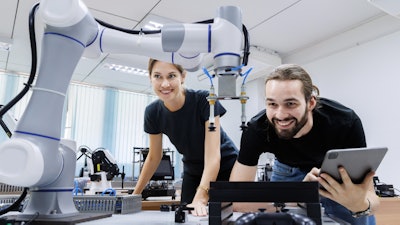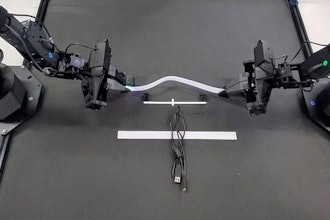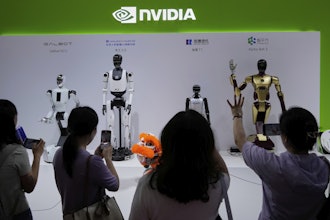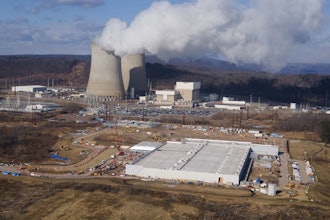
Aging workforces, a lack of suitable apprenticeships and waning interest from younger generations entering the job market has made filling open positions and keeping them filled a top concern for today’s manufacturers.
Against this backdrop, GenAI is emerging as a strong combative force. It is already delivering substantial returns, estimated at 3.7 times the investment per dollar spent, and for top leaders that are using GenAI, the returns are even higher with an average ROI of $10.30.
And there’s more. GenAI tools are also having a transformative effect on the existing manufacturing workforce, which will shape the future of the sector. McKinsey in its “Superagency in the workplace” report, finds that 62% of millennial workers, between 35- to 44-years-old, report high levels of expertise with AI. Their enthusiasm is making them natural champions of this transformational change.
We’re in the age of Superagency and it’s providing an opportunity the manufacturing industry cannot afford to miss.
At the moment, AI adoption in the manufacturing industry is still in the early-stages and varies widely depending on company size, culture, leadership mindset and data quality. There’s a growing need for explainability and trust in GenAI, with manufacturers requiring intuitive tools and proof of ROI. So, what are the key areas where manufacturers can expect to see the biggest Industrial AI gains?
1) A knowledge transfer bridge for new and experienced workers
Manufacturing training, especially when onboarding new workers, can be a lengthy and resource-intensive process. But with GenAI technologies at hand, it doesn’t have to be. GenAI can capture tacit knowledge from experienced workers and turn it into digestible, digital formats that build up an organization’s collective knowledge base. New workers can learn processes through intuitive bite-sized videos, interactive guides and AI agents, all while on the factory floor. This readily available intelligence on tap enables faster onboarding and reduces dependency on long apprenticeship programs.
Manufacturers that equip their workforce with familiar digital tools are also more likely to enhance engagement and improve productivity amongst digitally-native workers. Gen Z, for example, largely prefers YouTube video tutorials over reading instruction manuals, so manufacturing technology that mirrors their digital experiences will help companies attract younger talent.
2) A democratizing force for all, no coding required
GenAI has brought manufacturing back to natural language. Previously, frontline workers needed to know how to interrogate a complex system and write a query before they could even get information out, but now AI is moving from being a specialist tool to an intuitive assistant. Manufacturers can use GenAI tools to query databases and get support using natural language, which is helping to reduce the barrier to entry and speed up AI adoption amongst the workforce.
Manufacturers can apply personal AI experiences, such as prompting image generators or using chatbots, to industrial settings. This invites creativity by enabling workers to co-create solutions with AI and explore "what-if" scenarios in real-time. The same way users talk to ChatGPT to generate ideas, manufacturing workers can use GenAI on the factory floor to test out new production approaches or workflows.
3) And here’s the sweet spot – level up on the job with AI-enabled learning and development
To combat the ongoing skills gap, manufacturers need to prioritize reskilling existing workers and focus on in-house training initiatives. Connected worker tools such as Poka for instance, are making training interactive and personalized, which enhances engagement and reduces friction for upskilling.
In fact, workers don’t even need to know they’re interacting with GenAI as it can be embedded seamlessly into their workflows. For instance, digital work instructions on tablets can provide a digital record of tasks completions and career progression based on what videos the worker has watched and what they’ve read. This helps supervisors see where employees might be struggling and require additional training. This approach also fosters more worker autonomy by providing manufacturers with the pull-based learning tools to find answers on their own or reach out for help when needed.
4) Say goodbye to pen pushing as AI does the heavy lifting
AI has the potential to elevate existing job roles by automating routine and repetitive tasks such as quality checks and forecasting, also known as the 80/20 decisions. This not only shares the workload but also frees up time for manufacturers to focus on higher-value tasks that can foster creativity and encourage more worker initiative. As frontline manufacturers become more comfortable with AI, true human augmentation can become a reality through Agentic AI.
Unlike GenAI, Agentic AI goes beyond output generation. It’s a goal-oriented, autonomously acting system that can make decisions, sequence tasks and learn from feedback. For example, manufacturers won’t need to work line by line through an account spreadsheet to check that everything balances out as an AI agent that understands the rules can automate this task. It allows the worker to drill down further into the insights and start asking questions they never normally get round to, such as why supplier charges differ or what factors might be behind quality fluctuations. This shift in responsibilities can make the work more appealing for employees who are drawn to dynamic, tech-enabled environments.
AI as a Catalyst for a New Era of Manufacturing Progress
GenAI isn’t just a tool for efficiency. It’s reshaping what it means to work in manufacturing. Less than a year ago, GenAI wasn’t on the roadmap for many manufacturers but now it’s reimagining how frontline workers learn and solve problems and making the manufacturing industry more appealing for the next generation. The Age of Superagency is here and knocking at the door. Future success will depend on trust, strong leadership and a readiness to embrace change to open that door.
Maggie Slowik and Andrew Burton are Global Industry Directors for Manufacturing at IFS. For more information, visit www.IFS.com.






















